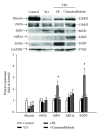Treatment of stress urinary incontinence by cinnamaldehyde, the major constituent of the chinese medicinal herb ramulus cinnamomi
- PMID: 24711852
- PMCID: PMC3966347
- DOI: 10.1155/2014/280204
Treatment of stress urinary incontinence by cinnamaldehyde, the major constituent of the chinese medicinal herb ramulus cinnamomi
Abstract
Stress urinary incontinence (SUI) is a common disorder in middle-aged women and the elderly population. Although surgical treatment of SUI has progressed, pharmacological therapies remain unelucidated. We screened potential herbal medicines against SUI with an ex vivo organ bath assay. Ramulus Cinnamomi and its major constituent cinnamaldehyde cause a high contractile force of the urethra and a low contractile force of blood vessels. Cinnamaldehyde dose-dependently reduced lipopolysaccharide-induced nitric oxide (NO) production and inducible nitric oxide synthase (iNOS) expression in RAW 264.7 cells. In the vaginal distension- (VD-) induced SUI model in mice, cinnamaldehyde significantly reversed the VD-induced SUI physical signs and reduced blood pressure. Cinnamaldehyde may offer therapeutic potential against SUI without the possible side effect of hypertension. The modulation of several SUI-related proteins including myosin, iNOS, survival motor neuron (SMN) protein, and superoxide dismutase 3 (SOD3) may play some crucial roles in the therapeutic approach against SUI. This information may offer clues to the pathogenesis of SUI and open additional avenues for potential therapy strategies.
Figures




References
-
- van der Vaart CH, de Leeuw JRJ, Roovers JPWR, Heintz APM. The effect of urinary incontinence and overactive bladder symptoms on quality of life in young women. BJU International. 2002;90(6):544–549. - PubMed
-
- Canda AE, Cinar MG, Turna B, Sahin MO. Pharmacologic targets on the female urethra. Urologia Internationalis. 2008;80(4):341–354. - PubMed
-
- Cherniack EP. Biofeedback and other therapies for the treatment of urinary incontinence in the elderly. Alternative Medicine Review. 2006;11(3):224–231. - PubMed
LinkOut - more resources
Full Text Sources
Other Literature Sources
Miscellaneous

